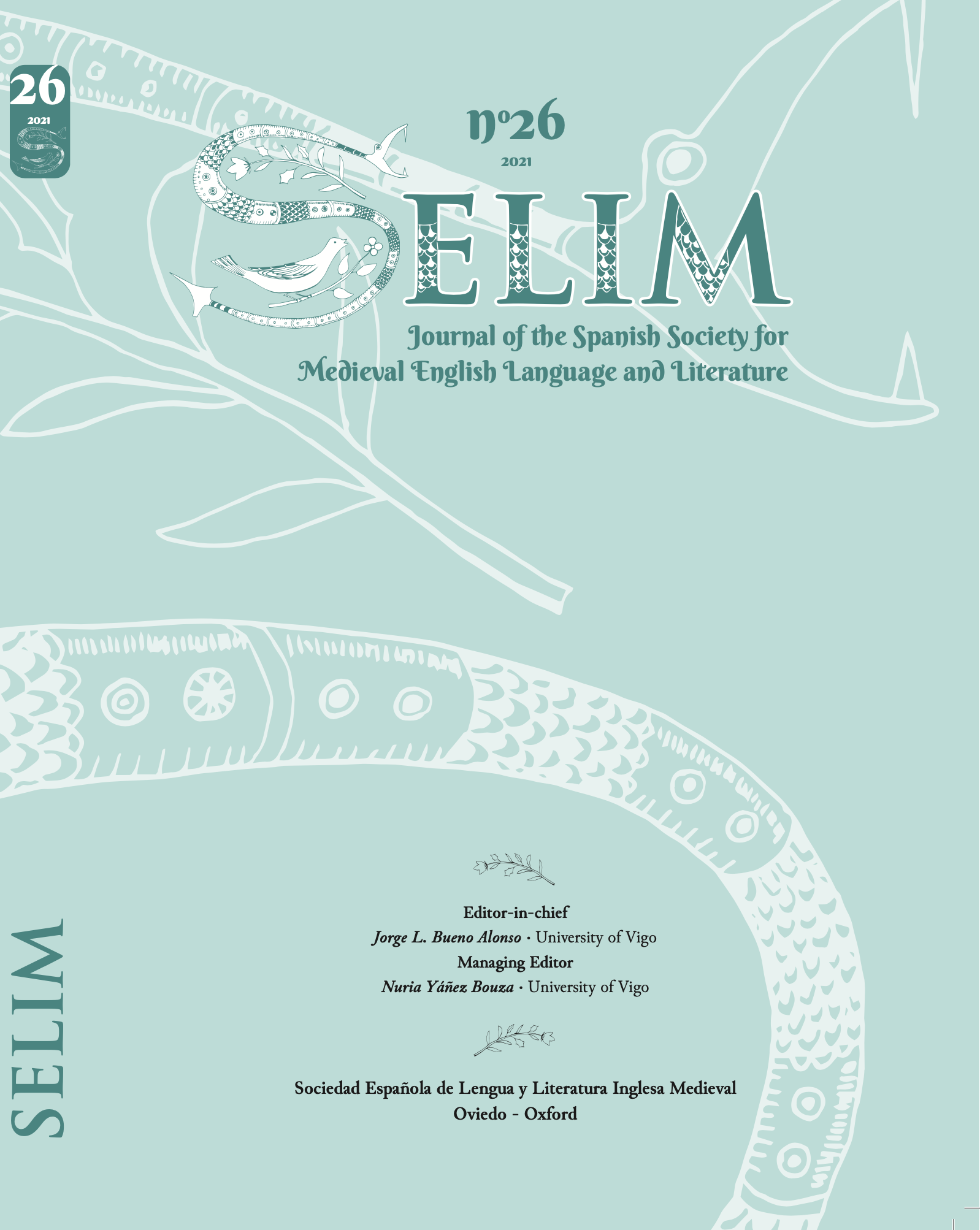Abstract
The aim of this article is to identify the Old English exponent for the semantic prime LIVE following the principles of the Natural Semantic Metalanguage theory (Wierzbicka 1996, Goddard & Wierzbicka 2002, Goddard 2011). The methodology applied in the study is based on previous research in Old English semantic primes. In these terms, a search for those Old English words conveying the meaning of the semantic prime LIVE is made. This search selects the verbs (ge)buan, drohtian, (ge)eardian, (ge)libban, and wunian as candidate words for prime exponent. Then, these verbs are analysed in terms of morphological, textual, semantic, and syntactic criteria. With this purpose, relevant information on these words has been gathered from different lexicographical and textual sources in Old English, such as the Dictionary of Old English, the Dictionary of Old English Corpus, and the lexical database of Old English Nerthus. After the analysis of these verbs, the conclusion is drawn that the Old English verb (ge)libban is selected as prime exponent, as it satisfies the requirements proposed by each criterion.
References
Bosworth, J. & T. N. Toller 1973 [1898]: An Anglo-Saxon Dictionary. Oxford, Oxford University Press. http://www.bosworthtoller.com
Croft, W. 1991: Syntactic Categories and Grammatical Relations. Chicago, University of Chicago Press.
de la Cruz Cabanillas, I. 2007: Semantic Primes in Old English: A Preliminary Study of Descriptors. SELIM 14: 37–58.
Goddard, C. 2002: The Search for the Shared Semantic Core of All Languages. In C. Goddard & A. Wierzbicka eds. Meaning and Universal Grammar. Theory and Empirical Findings. Vol. I. Amsterdam, John Benjamins: 5–40.
Goddard, C. ed. 2008: Cross-Linguistics Semantics. Amsterdam & Philadelphia, John Benjamins.
Goddard, C. 2011: Semantic Analysis: A Practical Introduction. New York, Oxford University Press.
Goddard, C. 2012: Semantic Primes, Semantic Molecules, Semantic Templates: Key Concepts in the NSM Approach to Lexical Typology. Linguistics 50.3: 711–743.
Goddard, C. & B. Peeters 2006: The Natural Semantic Metalanguage (NSM) Approach: An Overview with Reference to the Most Important Romance languages. In B. Peeters ed. Semantic Primes and Universal Grammar: Empirical Evidence from the Romance Languages. Amsterdam, John Benjamins: 13–38.
Goddard, C. & A. Wierzbicka 2002: Semantic Primes and Universal Grammar. In C. Goddard & A. Wierzbicka eds. Meaning and Universal Grammar. Theory and Empirical Findings. Vol. I. Amsterdam, John Benjamins: 41–85.
Guarddon Anelo, M. C. 2009: Un Análisis de las Propiedades Combinatorias de los Primitivos Semánticos a través de las Adposiciones Complejas en Inglés Antiguo. Revista Española de Lingüística 39.2: 93–122.
Hall, J. R. C. 1996: A Concise Anglo-Saxon Dictionary. Toronto, Toronto University Press.
Healey diPaolo, A. ed. with John Price Wilkin & Xin Xiang 2009: The Dictionary of Old English Web Corpus. Toronto. Dictionary of Old English Project. http://www.doe.utoronto.ca/pub/webcorpus.htm
Healey diPaolo, A., A. Cameron, A. Crandell Amos et al. eds. 2018: Dictionary of Old English: A to G online. Toronto, Dictionary of Old English Project.
Hiltunen, R. 1983: The Decline of the Prefixes and the Beginnings of the English Phrasal Verb. Turku, Turun Yliopisto.
Kastovsky, D. 1992: Semantics and Vocabulary. In R. Hogg ed. The Cambridge History of the English Language. Vol. I: The Beginnings to 1066. Cambridge, Cambridge University Press: 290–408.
Kay, C., J. Roberts, M. Samuels & I. Wotherspoon 2009: The Historical Thesaurus of the Oxford English Dictionary. University of Glasgow, Oxford University Press.
Kroonen, G. 2013: Etymological Dictionary of Proto-Germanic. Leiden, Brill.
Martín Arista, J. 2012a: The Old English Prefix Ge-: A Panchronic Reappraisal. Australian Journal of Linguistics 32.4: 411–433.
Martín Arista, J. 2012b: Lexical Database, Derivational Map and 3D Representation. RESLA – Revista Española de Lingüística Aplicada (Extra 1): 119–144.
Martín Arista, J. 2013: Recursivity, Derivational Depth and the Search for Old English Lexical Primes. Studia Neophilologica 85.1: 1–21.
Martín Arista, J. ed., L. García Fernández, M. Lacalle Palacios, A. E. Ojanguren López, & E. Ruiz Narbona 2009: Nerthus: An Online Lexical Database of Old English. http://www.nerthusproject.com
Martín Arista, J. & M. V. Martín de la Rosa 2006: Old English Semantic Primes: Substantives, Determiners and Quantifiers. ATLANTIS 28.2: 9–28.
Mateo Mendaza, R. 2013: The Old English Exponent for the Semantic Prime TOUCH. Descriptive and Methodological Questions. Australian Journal of Linguistics 33.4: 449–466.
Mateo Mendaza, R. 2016a: The Search for Old English Semantic Primes: The Case of HAPPEN. Nordic Journal of English Studies 15.1: 71–99.
Mateo Mendaza, R. 2016b: The Old English Exponent for the Semantic Prime MOVE. Australian Journal of Linguistics 36.4: 542–555.
Mateo Mendaza, R. 2020: Semantic Primes in Historical Languages. The Identification of the Old English Exponent for DO. Journal of English Studies 18: 125–152. https://doi.org/10.18172/jes.4467
Miller, T. 1959: Bede’s Ecclesiastical History of the English People. Part I, 2. London & New York & Toronto, Oxford University Press.
Mitchell, B. 1985: Old English Syntax. Vol. I. Oxford, Oxford University Press. Orel, V. 2003: A Handbook of Germanic Etymology. Leiden, Brill.
Peeters, B., M.-O. Junker, P. Farrel, P. Perini-Santos & B. Maher 2006: NSM Exponents and Universal Grammar in Romance: Speech; Actions, Events and Movement; Existence and Possession; Life and Death. In B. Peeters ed. Semantic Primes and Universal Grammar: Empirical Evidence from the Romance Languages. Amsterdam, John Benjamins: 111–136.
Ringe, D. & A. Taylor 2014: The Development of Old English. Oxford, Oxford University Press.
Skeat, W. 1993: The Concise Dictionary of English Etymology. Great Britain, Wordsworth Edition Ltd.
Sweet, H. 1973 [1897]: The Student’s Dictionary of Anglo-Saxon. New York & London, The MacMillan Company.
Thorpe, B. 1844: The Homilies of the Anglo-Saxon Church. London, printed for the Ælfric Society.
Wierzbicka, A. 1996: Semantics. Primes and Universals. Oxford, Oxford University Press. Wierzbicka. A. 2002: Semantic Primes and Universal Grammar in Polish. In C. Goddard & A. Wierzbicka eds. Meaning and Universal Grammar. Theory and Empirical Findings. Vol. II. Amsterdam, John Benjamins: 65–144.
Wierzbicka, A. 2006: English: Meaning and Culture. New York, Oxford University Press.




